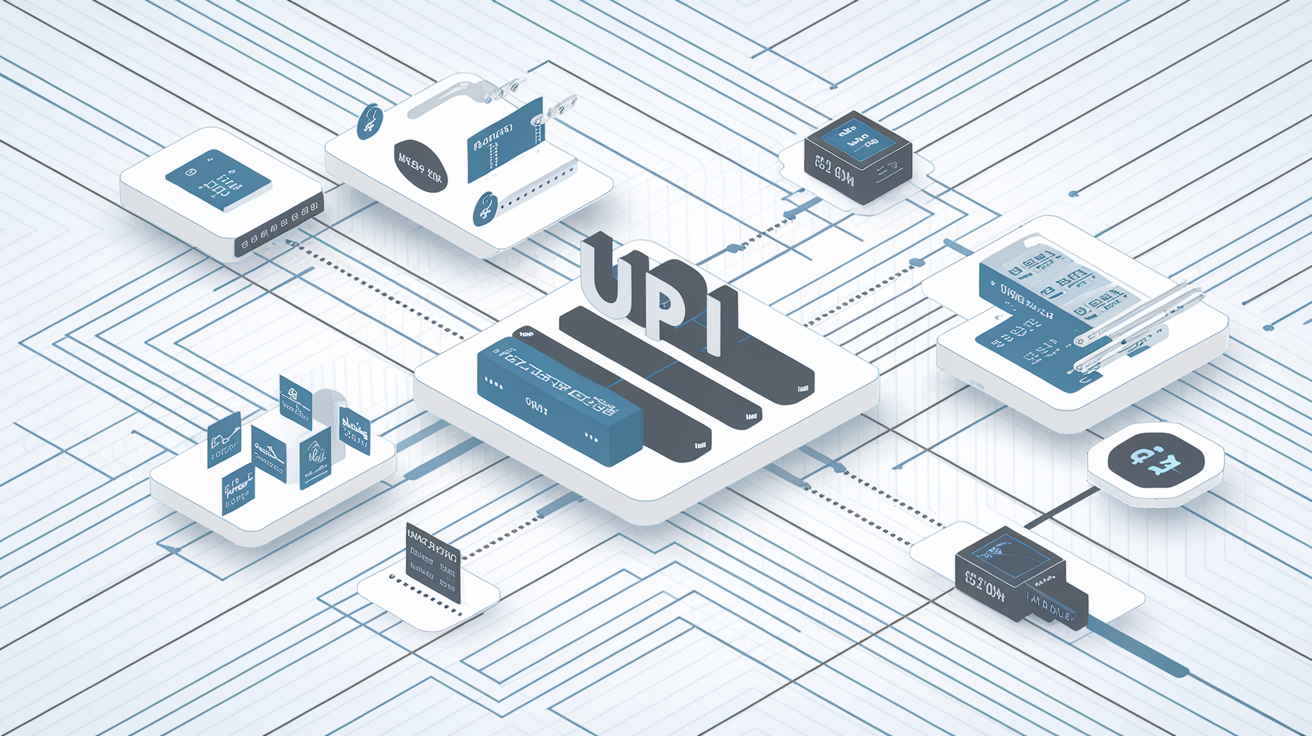Ever witnessed 405 million transactions processed in a single day? That’s what India’s UPI payment system handled in January 2024—nearly 5,000 transactions every second. Not even Visa or Mastercard can match that volume.
The payments revolution isn’t coming from Silicon Valley; it’s already here in India’s homegrown UPI system.
This deep dive will reveal the ingenious system design behind UPI’s phenomenal success and why UPI is the future of digital payments worldwide. I’ll break down the architecture that handles billions of transactions with near-zero downtime.
But here’s what most technologists miss: UPI isn’t just a technical marvel—it’s a blueprint for financial inclusion that could transform how 1.4 billion people access money. The question is: how did a government-backed initiative outpace the trillion-dollar payment giants?
The UPI Revolution: Transforming Digital Payments

A. How UPI simplified person-to-person transfers
Remember when sending money to friends meant bank visits, IFSC codes, and waiting days for the transfer? UPI killed all that nonsense.
The UPI payment system stripped away the complexity with a dead-simple approach: your phone number is your banking identity. No more memorizing account numbers or branch codes.
Instead of asking “What’s your account number?” we now just ask “What’s your UPI ID?” And boom—money sent in seconds.
The magic happens because UPI links your mobile number to all your bank accounts through a single interface. You pick which account to use, enter a PIN, and that’s it. The UPI system architecture handles the rest behind the scenes.
B. Breaking down the 24/7 instant settlement advantage
The 9-to-5 banking hours? UPI threw that concept in the trash.
With UPI, money moves at 3 AM on Sunday just as easily as at noon on Monday. This wasn’t just convenient—it completely shifted how Indians think about money.
The technical brilliance of UPI’s design lies in its real-time gross settlement system that:
- Confirms transactions in seconds (not hours or days)
- Works during holidays, weekends, and midnight snack runs
- Eliminates the traditional banking downtime
This 24/7 availability isn’t just a feature—it’s transformed how businesses operate, enabling commerce that never sleeps.
C. UPI’s explosive growth statistics in India
The numbers don’t just tell a story—they scream it:
| Year | Monthly Transactions | Value (in billions USD) |
|---|---|---|
| 2016 | < 1 million | < 0.1 |
| 2023 | > 9 billion | > 180 |
That’s not growth. That’s an explosion.
UPI processes more transactions daily than many countries do in a month. The UPI payment scalability has been tested like nothing before, handling peak loads of 500+ transactions per second.
What’s crazy? Most Indians adopted it faster than they got smartphones.
D. Why global markets are taking notice
Global financial players aren’t just watching UPI—they’re scrambling to copy it.
Countries from Singapore to UAE are building UPI-inspired systems. Google even recommended the UPI framework to the US Federal Reserve as a model for instant payment solutions.
Why? Because UPI solved three massive problems other systems haven’t:
- Zero transaction costs (unlike credit cards)
- Universal compatibility across banks
- Instant settlement without intermediaries
The future of mobile payments globally looks increasingly like what India built first. UPI isn’t just winning the digital payment revolution in India—it’s writing the playbook for the world.
System Architecture Behind UPI’s Success

A. The four-layer technical framework explained
Ever wonder how UPI actually works? At its core, UPI operates on a four-layer architecture that’s basically a digital payment superhighway.
-
User Interface Layer: This is what you interact with – the payment apps like PhonePe, Google Pay, or your bank’s UPI app.
-
Payment Service Provider Layer: These guys handle your payment requests and connect you to the banking systems.
-
NPCI Layer: The traffic control center of UPI payments, processing everything in real-time.
-
Banking Layer: Where your actual money lives – connects to core banking systems.
What makes this structure special? It’s completely modular. When Google Pay adds a cool new feature, they don’t need to rewire the entire UPI system. They just update their part of the interface layer.
B. Role of NPCI as the central clearing house
The National Payments Corporation of India isn’t just another acronym – it’s the beating heart of UPI’s system architecture.
Think of NPCI as the ultimate referee in a high-stakes game. Every single UPI transaction (we’re talking billions here) flows through NPCI’s systems. They’re handling:
- Real-time transaction routing between banks
- Settlement of funds between different banks
- Maintaining the central database of all UPI IDs
- Setting the rules and standards everyone has to follow
The genius move? NPCI created a system where competitors actually work together. Your HDFC account works perfectly with your friend’s SBI account because NPCI makes them play nice.
C. How virtual payment addresses enhance security
Remember writing checks with your account number sprawled across the bottom? UPI said “nope, too risky” and created Virtual Payment Addresses instead.
Your UPI ID (like yourname@okicici) is basically a digital disguise for your actual banking details. When you send money, you’re never exposing:
- Your account number
- IFSC codes
- Personal banking credentials
- Debit card details
This virtual addressing system creates a bulletproof layer between your money and potential scammers. And here’s the kicker – it also made payments incredibly simple. No more memorizing 16-digit card numbers or copying account details.
D. Real-time authorization flow and settlement mechanisms
The UPI payment flow is ridiculously fast – from tapping “pay” to getting that “payment successful” notification happens in milliseconds. But there’s serious complexity behind that speed:
-
Initiation: Your payment app sends the transaction request to its PSP server
-
Verification: The PSP forwards this to NPCI, which validates both sender and receiver details
-
Authorization: NPCI routes the request to your bank, you authenticate (usually with a PIN), and your bank confirms
-
Settlement: Once authorized, NPCI triggers the inter-bank settlement process
What’s wild is how UPI balances immediate confirmation with behind-the-scenes settlement. You get instant notification that your payment worked, while banks handle the actual money movement throughout the day.
E. API integration capabilities for developers
UPI wasn’t just built for users – it was designed to be a developer’s playground too.
The system exposes standardized APIs that let developers integrate UPI payments into practically anything. This openness sparked an explosion of innovation in India’s fintech scene.
Developers can tap into:
- Payment initiation APIs
- Collection request APIs
- Status check and verification endpoints
- Refund and cancellation flows
The beauty of UPI’s architecture is that a two-person startup can build on the same payment rails as billion-dollar companies. This level playing field is why we’ve seen such diverse UPI implementations – from QR code payments at street vendors to in-app purchases in mobile games.
Technical Innovations That Set UPI Apart

A. QR code implementation for seamless transactions
The magic of UPI happens when you scan a simple QR code. It’s brilliant in its simplicity. Unlike clunky card machines or lengthy bank transfers, UPI’s QR implementation created a zero-hardware solution that works anywhere—from high-end stores to roadside vegetable vendors.
What makes UPI’s QR approach special? It’s dynamic. While other payment systems use static QRs tied to single accounts, UPI enables QRs that can request specific amounts for specific purposes. A street vendor with just a laminated QR printout can accept digital payments without any tech investment. This innovation single-handedly brought millions of small merchants into the digital payment ecosystem.
B. Single-click multi-bank account management
Remember when you needed separate apps for each bank account? UPI killed that hassle. One app now connects all your accounts, letting you switch between them with a single tap.
The technical wizardry behind this is in how UPI created a virtual payment address (VPA) layer that abstracts actual bank details. Your username@bankname becomes your financial identity, eliminating the need to share sensitive account information. This virtual addressing system created a level of convenience that no other payment system has matched globally.
C. The zero-cost advantage: how the system eliminated fees
The most disruptive innovation in UPI’s design was making transactions free. No hidden charges. No processing fees. Nothing.
How did they pull this off? By creating a non-profit shared infrastructure where banks participate as equal stakeholders rather than competing payment rails. The system design eliminated intermediaries that typically take a cut of each transaction.
This cost structure wasn’t just a pricing decision—it was architected into the system from day one, creating network effects that drove unprecedented adoption rates.
Security By Design: UPI’s Architecture Safeguards

Two-factor authentication implementation
The UPI payment system isn’t just fast—it’s fortress-level secure. Every UPI transaction requires two distinct verification steps. First, you enter your UPI PIN (something you know), and second, you use your device (something you have). This simple yet powerful combination makes account takeovers incredibly difficult.
Unlike traditional banking where you might just enter card details, UPI never lets a transaction complete without both factors being verified. Even if someone somehow got your PIN, they’d still need physical access to your registered mobile device to complete transactions.
Tokenization and data protection measures
Remember the last time you worried about sharing your bank details online? UPI eliminates that concern entirely.
Instead of passing your actual account information during transactions, UPI creates unique digital tokens that serve as temporary references. These tokens are one-time use and completely worthless to hackers if intercepted.
Your sensitive financial data never actually travels across networks during payments—just these meaningless tokens that can’t be reverse-engineered or reused. This tokenization approach is why UPI’s technical design has become a global benchmark for secure digital payments.
Transaction fraud prevention mechanisms
UPI’s architecture includes multiple fraud detection layers working in real-time:
- Velocity checks that flag unusually frequent transactions
- Amount pattern analysis that spots suspicious deviations from your normal spending
- Geolocation verification that questions transactions from unexpected locations
- Machine learning systems that continuously adapt to new fraud patterns
Regulatory compliance features
The UPI system architecture was built with Reserve Bank of India regulations as its foundation. Every transaction is digitally signed, encrypted, and immutably logged for audit purposes. The system maintains a perfect balance—strong enough to meet the strictest regulatory requirements while remaining lightweight enough to process millions of transactions instantly.
Building for Scale: How UPI Handles Billions of Transactions

A. Database management and replication strategies
Ever wonder how UPI handles those crazy transaction volumes? The secret sauce is in how it manages data. UPI’s database architecture uses sharding techniques that split transaction data across multiple servers based on user IDs or transaction types.
They don’t mess around with replication either. UPI implements multi-region synchronous replication ensuring transactions are saved in at least three different data centers simultaneously. If one goes down, the others keep things running.
What’s cool is their hybrid approach – combining SQL databases for account information (where ACID compliance matters) with NoSQL solutions like Cassandra for handling transaction logs that need lightning-fast write speeds.
B. Load balancing techniques during peak transaction times
During festivals like Diwali, UPI transaction volumes go through the roof. Their load balancing game is next-level stuff.
UPI uses predictive scaling algorithms that actually anticipate traffic spikes before they happen. Seriously. The system analyzes historical patterns and automatically provisions additional resources.
They’ve implemented a clever rate-limiting strategy too, where non-critical operations take a backseat during peak loads. And get this – geographic routing directs transactions to the physically closest data centers, shaving precious milliseconds off response times.
C. The microservices approach to UPI infrastructure
The UPI payment system isn’t some monolithic dinosaur. It’s broken down into specialized microservices that can scale independently:
- Authentication services
- Transaction processing engines
- Settlement systems
- Notification services
Each service communicates through encrypted message queues with built-in retry mechanisms. This architecture lets them update individual components without taking down the whole system.
D. Disaster recovery and redundancy measures
When you’re handling billions in transactions daily, downtime isn’t an option. UPI’s disaster recovery plan is hardcore.
They maintain active-active deployments across geographically diverse regions. All data centers operate simultaneously, not just sitting around as backups.
Their system runs automatic failover tests weekly, simulating different disaster scenarios. Plus, they’ve built a “chaos engineering” team that deliberately breaks parts of the system to ensure recovery mechanisms work flawlessly.
The real magic? Most users never notice these behind-the-scenes gymnastics happening. Your payment just works.
The Developer Ecosystem: Extending UPI’s Capabilities

A. Open API Framework that Powers Innovation
The magic of UPI isn’t just in what it does, but what it lets others build. UPI’s open API framework is like giving developers the keys to India’s financial kingdom. Unlike closed payment systems that keep their code locked up tight, UPI hands out developer documentation like candy.
This openness isn’t an accident—it’s by design. The National Payments Corporation of India (NPCI) knew that for UPI to transform payments, it needed an army of builders extending what’s possible. The UPI developer API provides standardized endpoints for everything from payment initiation to verification, all wrapped in robust security protocols.
B. Key SDKs and Integration Options
Got a mobile app? There’s a UPI SDK for that. Building an e-commerce platform? UPI’s got you covered there too.
The integration landscape includes:
| Integration Type | Best For | Implementation Complexity |
|---|---|---|
| Direct API Integration | Custom payment flows | High |
| UPI Deep Linking | Quick implementation | Low |
| Intent Calling | Android applications | Medium |
| Payment Web SDK | Web storefronts | Medium |
The beauty here? You don’t need to be a payments expert to implement UPI. A decent developer can have basic UPI functionality up and running in days, not months.
C. Third-party Application Success Stories
The UPI ecosystem has birthed some massive success stories. PhonePe and Google Pay weren’t even on the radar before UPI—now they process millions of transactions daily.
But it’s not just payment apps. Food delivery platforms like Swiggy integrated UPI and saw cart abandonment rates plummet. E-commerce sites reduced payment friction. Even small businesses jumped into digital payments through simple QR codes generated by UPI-powered apps.
D. Building Custom Payment Flows with UPI
The real power comes when you start building custom payment experiences.
Want to split restaurant bills automatically? UPI’s collect request API makes it possible. Need recurring payments for subscriptions? UPI AutoPay has your back. Looking to disburse loans or insurance payouts instantly? UPI’s architecture handles it seamlessly.
The UPI technical design deliberately separates the payment initiation layer from the processing layer, giving developers freedom to create interfaces that make sense for their specific use cases while maintaining the rock-solid security that makes the UPI payment system trustworthy.
Future Roadmap: Where UPI is Headed

Cross-border payment capabilities
UPI’s next big leap? Going global. Indian tourists already struggle with the payment fragmentation when traveling abroad. Why can’t they just use UPI everywhere?
NPCI International Payments Limited (NIPL) is already making this happen. They’ve partnered with countries like Singapore, UAE, Nepal, and France to expand UPI acceptance. Soon, scanning a QR code to pay for your coffee in Tokyo might be as normal as doing it in Bangalore.
The technical challenges are massive though. Currency conversion, compliance with international regulations, and settlement processes all need rethinking. But the UPI system architecture is being modified to handle these complexities without sacrificing its signature speed.
Integration with emerging technologies like blockchain
The UPI technical design isn’t standing still. Blockchain integration is being explored to make transactions even more secure and transparent.
What this means practically:
- Smart contracts could enable automatic payments when certain conditions are met
- Cross-border settlements could happen in seconds instead of days
- Transaction history becomes immutable and fully verifiable
NPCI is already running pilot programs testing blockchain’s compatibility with the UPI payment system. The goal isn’t to replace UPI’s core architecture but to enhance it in ways that make the digital payment revolution in India even more impactful.
UPI credit and lending infrastructure possibilities
The missing piece in UPI’s puzzle has been credit. That’s changing fast.
UPI now supports credit card linking, but that’s just the beginning. The real game-changer will be micro-lending right at the payment interface. Imagine buying a laptop and getting instantly approved for a payment plan right on the UPI app.
The backend systems are being modified to analyze transaction history and create real-time creditworthiness profiles. For millions of Indians without credit history, this could be their first entry into formal credit systems.
Enhanced user experience features in development
The future UPI experience won’t just be about payments. It’s evolving into a financial OS with features like:
- Voice-enabled payments for accessibility
- AI-powered spending insights and budgeting
- Augmented reality for visualizing financial data
- Unified financial dashboard across all linked accounts
The how UPI payment works fundamentals won’t change, but the experience will become more intuitive. Developer APIs are being expanded to let third parties create these enhanced experiences while maintaining the rock-solid security and scalability that made UPI successful in the first place.

India’s Unified Payments Interface has redefined digital transactions through an elegant blend of technical excellence and user-centric design. From its revolutionary architecture and robust security frameworks to its ability to process billions of transactions seamlessly, UPI has demonstrated how thoughtful system design can transform an entire financial ecosystem. The open developer ecosystem has further extended UPI’s reach, making it accessible across platforms and use cases.
As UPI continues to evolve with new features and global expansion plans, its fundamental principles of interoperability, security, and simplicity will guide its growth. Whether you’re a developer building on the platform, a business integrating payment solutions, or simply a user enjoying the convenience of instant transfers, UPI represents not just India’s payment innovation but a blueprint for digital financial infrastructure worldwide. The future of payments is real-time, secure, and accessible—and UPI is leading the way.



















